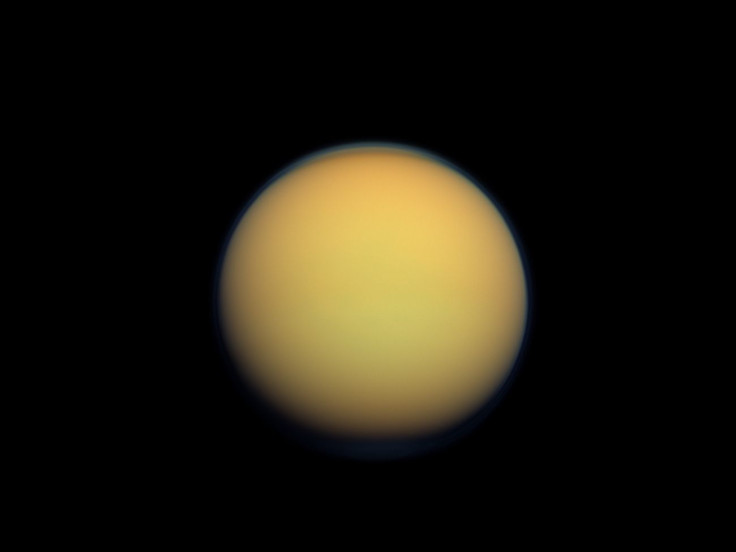Cassini Data Helps NASA Find Noxious Ice Cloud On Saturn’s Moon Titan

NASA’s Cassini plunged into Saturn’s atmosphere on Sept. 15, but scientists are still studying the data it sent back and are making several in-roads into understanding Saturn and its moons. The latest discovery from the Cassini data shows the presence of a toxic hybrid ice in a wispy cloud above Titan’s (Saturn’s Moon) South Pole.
These findings show a complex chemical environment around Titan. The gaseous cloud known as a Noxious Ice Cloud on the Moon’s stratosphere give us insight into the organic molecules present on Titan.
Data from the Composite Infrared Spectrometer (CIRS) onboard Cassini has revealed that the cloud is located at an altitude of about 100 to 130 miles. This cloud was found much higher than the Methane rain clouds found in Titan’s troposphere. According to a press release by NASA, the new cloud covers a large area near the South Pole, from about 75 to 85 degrees south latitude.
A chemical trail left by the cloud was detected using the CIRS instrument and matched with the spectral signature displayed by the cloud. The spectral signature (individual components) of the cloud was analyzed in the laboratory to reveal a simple composition.
The release said that "the exotic ice in the cloud is a combination of the simple organic molecule hydrogen cyanide together with the large ring-shaped chemical benzene. The two chemicals appear to have condensed at the same time to form ice particles, rather than one being layered on top of the other."
The cloud build-up is found in whichever pole is experiencing winter. This was because a current of warm gases circulates over the surface of the moon from hotter to colder parts. "This circulation reverses direction when the seasons change; leading to a build-up of clouds at whichever pole is experiencing winter," said the release. Cassini sent back evidence of this cloud on the North Pole of Titan and then 13 years later, at the South Pole.
According to Carrie Anderson, CIRS co-investigator and member of NASA’s Goddard Space Flight Center in Greenbelt, Maryland, "this cloud represents a new chemical formula of ice in Titan’s atmosphere. What’s interesting is that this noxious ice is made of two molecules that condensed together out of a rich mixture of gases at the South Pole."
"CIRS acts as a remote-sensing thermometer and as a chemical probe, picking out the heat radiation emitted by individual gases in an atmosphere," said F. Michael Flasar, the CIRS principal investigator at Goddard. "And the instrument does it all remotely, while passing by a planet or moon."
This temperature data was used to sift through a variety of molecules that they found in the atmosphere. They found three sets of chemical signatures that matched readings taken from July to November 2015.
The ice was formed in a laboratory using an ice chamber that simulated the atmosphere of Titan. The team synthesized the ice individually and then as a mixture and found that the closest matches to the Cassini readings were obtained when the two gases were allowed to condense together.
Readings from 2005, when co-condensed ice was found near the North Pole were compared to the recent readings. It was found that the North Pole cloud "formed at a much lower altitude, below 93 miles (150 kilometers), and had a different chemical composition: hydrogen cyanide and cyanoacetylene, one of the more complex organic molecules found in Titan’s atmosphere."
The two clouds were different because of the seasonal variations at the North and South Pole. According to Anderson, The northern cloud was spotted about two years after the northern winter solstice, but the southern cloud was spotted about two years before the southern winter solstice. It’s possible that the mixtures of gases were slightly different in the two cases or that temperatures had warmed up a bit by the time the north polar cloud was spotted, or both. This effectively explains the different compositions for the North and South Pole.
© Copyright IBTimes 2024. All rights reserved.





















